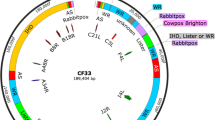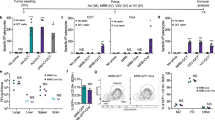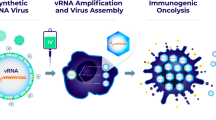Abstract
Tumor directed gene therapy for the purpose of destroying cancer cells through replicative “oncolysis” or by intratumoral expression of toxic or immunostimulatory genes requires an efficient, tumor targeted vector. Vectors are limited by inefficient replication in vivo, inefficient tumor targeting, and safety concerns. As a unique approach to addressing these limitations, our laboratory has studied poxviruses as tumor selective replicating vectors. The best in vivo antitumor results achieved to date have been with a mutated WR strain of vaccinia virus. The unique advantage of this strain of vaccinia over other vectors currently being explored for this purpose is the efficiency of in vivo replication. Intradermal injection of 106 pfu of the wild type (non-mutated) vaccinia in non-human primates leads to a 108 cm2 zone of necrosis in 8 days – directly related to cellular destruction from viral replication. We have mutated the virus through insertional deletion of both the thymidine kinase (TK) gene and vaccinia growth factor (VGF) gene. The mutant virus no longer causes destruction of normal tissue, but has completely preserved replication efficiency in tumor tissue and can safely be delivered systematically to successfully treat subcutaneous tumors in mice. Plans are now underway for clinical trials.
This is a preview of subscription content, access via your institution
Access options
Subscribe to this journal
Receive 12 print issues and online access
$259.00 per year
only $21.58 per issue
Buy this article
- Purchase on Springer Link
- Instant access to full article PDF
Prices may be subject to local taxes which are calculated during checkout






Similar content being viewed by others
References
Fenner F . In: Fields BN, Knipe DM, Howley PM, eds Fields Virology Lippincott-Raven: Philadelphia 1996 2673–2700
Fentiman IS, Rubens RD, Hayward JI . A comparison of intracavitary talcum and tetracycline for the control of pleural effusion secondary to breast cancer Eur J Cancer Clin Oncol 1986 22: 1079
Fenner F, Wittek R, Dumbell KR . The Orthopoxviruses Academic Press: New York 1989 143–170
Antoine G, Scheiflinger F, Dorner F, Falkner FG . The complete genomic sequence of the modified vaccinia Ankara strain: comparison with other orthopoxviruses Virology 1998 242: 365–396
Goebel SJ, Johnson GP, Perkus ME, Davis SW, Winslow JP, Paoletti E . The complete DNA sequence of vaccinia virus Virology 1990 179: 247–266
Hsiao JC, Chung CS, Chang W . Vaccinia virus envelope D8L protein binds to cell surface chondroitin sulfate and mediates the adsorption of intracellular mature virions to cells J Virol 1999 73: 8750–8761
Chung CS, Hsiao JC, Chang YS, Chang W . A27L protein mediates vaccinia virus interaction with cell surface heparan sulfate J Virol 1998 72: 1577–1585
Moss B, Earl PL . Expression of proteins in mammalian cells using vaccinia viral vectors Curr Prot Mol Biol 1998 43: 16
McIntosh AAG, Smith GL . Vaccinia virus glycoprotein A34R is required for infectivity of extracellular enveloped virus J Virol 1996 70: 272–281
Seet BT, McFadden G . Viral chemokine-binding proteins J Leukoc Biol 2002 72: 24–34
Alcami A, Symons JA, Collins PD, Williams TJ, Smith GL . Blockade of chemokine activity by a soluble chemokine binding protein from vaccinia virus J Immunol 1998 160: 624–633
Mahalingam S, Karupiah G . Modulation of chemokines by poxvirus infections Curr Opin Immunol 2000 12: 409–412
Symons JA, Alcami A, Smith GL . Vaccinia virus encodes a soluble type I interferon receptor of novel structure and broad species specificity Cell 1995 81: 551–560
Najarro P, Traktman P, Lewis JA . Vaccinia virus blocks gamma interferon signal transduction: viral VH1 phosphatase reverses Stat1 activation J Virol 2001 75: 3185–3196
Smith VP, Bryant NA, Alcami A . Ectromelia, vaccinia and cowpox viruses encode secreted interleukin-18–binding proteins J Gen Virol 2000 81: 1223–1230
Calderara S, Xiang Y, Moss B . Orthopoxvirus IL-18 binding proteins: affinities and antagonist activities Virology 2001 279: 22–26
Novick D, Kim SH, Fantuzzi G, Reznikov LL, Dinarello CA, Rubinstein M . Interleukin-18 binding protein: a novel modulator of the Th1 cytokine response Immunity 1999 10: 127–136
Engelstad M, Howard ST, Smith GL . A constitutively expressed vaccinia gene encodes a 42-kDa glycoprotein related to complement control factors that forms part of the extracellular virus envelope Virology 1992 188: 801–810
Bowie A, Kiss-Toth E, Symons JA, Smith GL, Dower SK, O'Neill LA . A46R and A52R from vaccinia virus are antagonists of host IL-1 and toll-like receptor signaling Proc Natl Acad Sci USA 2000 97: 10162–10167
Howard ST, Chan YS, Smith GL . Vaccinia virus homologues of the Shope fibroma virus inverted terminal repeat proteins and a discontinuous ORF related to the tumor necrosis factor receptor family Virology 1991 180: 633–647
Smith GL, Howard ST, Chan YS . Vaccinia virus encodes a family of genes with homology to serine proteinase inhibitors J Gen Virol 1989 70: 2333–2343
Sutter G, Moss B . Novel vaccinia vector derived from the host range restricted and highly attenuated MVA strain of vaccinia virus Dev Biol Stand 1995 84: 195–200
Blanchard TJ, Alcami A, Andrea P, Smith GL . Modified vaccinia virus Ankara undergoes limited replication in human cells and lacks several immunomodulatory proteins: implications for use as a human vaccine J Gen Virol 1998 79: 1159–1167
Deonarain R, Alcami A, Alexiou M, Dallman MJ, Gewert DR, Porter AC . Impaired antiviral response and alpha/beta interferon induction in mice lacking beta interferon J Virol 2000 74: 3404–3409
van Den Broek M, Bachmann MF, Kohler G, Barner M, Escher R, Zinkernagel R, Kopf M . IL-4 and IL-10 antagonize IL-12–mediated protection against acute vaccinia virus infection with a limited role of IFN-gamma and nitric oxide synthetase 2 J Immunol 2000 164: 371–378
Whitman ED, Tsung K, Paxson J, Norton JA . In vitro and in vivo kinetics of recombinant vaccinia virus cancer-gene therapy Surgery 1994 116: 183–188
Moss B, Carroll MW, Wyatt LS et al. Host range restricted, non-replicating vaccinia virus vectors as vaccinia candidates, in Design and Production of Vaccines New York: Plenum Press 1996 7–13
Ricketts TF . Diagnosis of Smallpox London: Cassell and Company 1966 6–13
Neeman M, Abramovitch R, Schiffenbauer YS, Tempel C . Regulation of angiogenesis by hypoxic stress: from solid tumours to the ovarian follicle Int J Exp Pathol 1997 78: 57–70
McCart JA, Hu YK, Alexander HR, Libutti SK, Moss B, Bartlett DL . A combined thymidine kinase/vaccinia growth factor deleted vaccinia virus as a vector for cancer gene therapy Proc Am Soc Gene Ther 1999 2: 160
Puhlmann M, Brown CK, Gnant M et al. Vaccinia as a vector for tumor directed gene therapy: biodistribution of a thymidine kinase deleted mutant Cancer Gene Ther 2000 7: 66–73
Gnant MF, Noli LA, Irvine KR et al. Tumor specific gene delivery using recombinant vaccinia virus in a rabbit model of unresectable liver metastases — pattern of gene expression, vector elimination and immune response J Natl Cancer Inst 1999 91: 1744–1750
McCart JA, Puhlmann M, Lee J et al. Complex interactions between the replicating oncolytic effect and the enzyme/prodrug effect of vaccinia-mediated tumor regression Gene Ther 2000 7: 1217–1223
Gnant MFX, Puhlmann M, Alexander HR Jr, Bartlett DL . Systemic administration of a recombinant vaccinia virus expressing the cytosine deaminase gene and subsequent treatment with 5-fluorocytosine leads to tumor specific gene expression and prolongation of survival in mice Cancer Res 1999 59: 3396–3404
Puhlmann M, Gnant M, Brown CK, Alexander HR, Bartlett DL . Thymidine kinase deleted vaccinia virus expressing purine nucleoside phosphorylase as a vector for tumor directed gene therapy Hum Gene Ther 1999 10: 649–657
McCart JA, Ward JM, Lee J et al. Systemic cancer therapy with a tumor selective vaccinia virus mutant lacking thymidine kinase and vaccinia growth factor genes Cancer Res 2001 61: 8751–8757 12-15 (Reference Type: Generic)
Buller RML, Chakrabarti S, Cooper JA, Twardzik DR, Moss B . Deletion of the vaccinia virus growth factor gene reduces virus virulence J Virol 1988 62: 866–874
Bischoff JR, Kim DH, Williams A et al. An adenovirus mutant that replicates selectively in p53-deficient human tumor cells [see comments] Science 1996 274: 373–376
Ray C, Black RA, Kronheim SR et al. Viral inhibition of inflammation: cowpox virus encodes an inhibitor of the interleukin-1α converting enzyme Cell 1992 69: 597–604
Kettle S, Blake NW, Law KM, Smith GL . Vaccinia virus serpins B13R (SPI-2) and B22R (SPI-1) encode Mr 385 and 40K, intracellular polypeptides that do not affect virus virulence in a murine intranasal model Virology 1995 206: 136–147
Shisler JL, Isaacs SN, Moss B . Vaccinia virus serpin-1 deletion mutant exhibits a host range defect characterized by low levels of intermediate and late mRNAs Virology 1999 262: 298–311
Perkus ME, Goebel SJ, Davis SW et al. Vaccinia virus host range genes Virology 1990 179: 276–286
Chung CS, Vasilevskaya IA, Wang SC, Bair CH, Chang W . Apoptosis and host restriction of vaccinia virus in RK13 cells Virus Res 1997 52: 121–132
Oguiura N, Spehner D, Drillien R . Detection of a protein encoded by the vaccinia virus C7L open reading frame and study of its effect on virus multiplication in different cell lines J Gen Virol 1993 74: 1409–1413
Ramsey-Ewing AL, Moss B . Complementation of a vaccinia virus host-range K1L gene deletion by the nonhomologous CP77 gene Virology 1996 222: 75–86
Galmiche MC, Rindisbacher L, Wels W, Wittek R, Buchegger F . Expression of a functional single chain antibody on the surface of extracellular enveloped vaccinia virus as a step towards selective tumour cell targeting J Gen Virol 1997 78: 3019–3027
Hu Y, Lee J, McCart JA et al. Yaba like disease virus: an alternating replicating pox vector for cancer gene therapy J Virol 2001 75: 10300–10308
Sharma DP, Ramsay AJ, Maguire DJ, Rolph MS, Ramshaw IA . Interleukin-4 mediates down regulation of antiviral cytokine expression and cytotoxic T-lymphocyte responses and exacerbates vaccinia virus infection in vivo J Virol 1996 70: 7103–7107
Perera LP, Goldman CK, Waldmann TA . Comparative assessment of virulence of recombinant vaccinia viruses expressing IL-2 and IL-15 in immunodeficient mice Proc Natl Acad Sci USA 2001 98: 5146–5151
Karupiah G, Woodhams CE, Blanden RV, Ramshaw IA . Immunobiology of infection with recombinant vaccinia virus encoding murine IL-2. Mechanisms of rapid viral clearance in immunocompetent mice J Immunol 1991 147: 4327–4332
Ruby J, Bluethmann H, Aguet M, Ramshaw IA . CD40 ligand has potent antiviral activity Nat Med 1995 1: 437–441
Sambhi SK, Kohonen-Corish MR, Ramshaw IA . Local production of tumor necrosis factor encoded by recombinant vaccinia virus is effective in controlling viral replication in vivo Proc Natl Acad Sci USA 1991 88: 4025–4029
Ramirez JC, Gherardi MM, Rodriguez D, Esteban M . Attenuated modified vaccinia virus Ankara can be used as an immunizing agent under conditions of preexisting immunity to the vector J Virol 2000 74: 7651–7655
Gherardi MM, Ramirez JC, Rodriguez D et al. IL-12 delivery from recombinant vaccinia virus attenuates the vector and enhances the cellular immune response against HIV-1 Env in a dose-dependent manner J Immunol 1999 162: 6724–6733
Lattime EC, Lee SS, Eisenlohr LC, Mastrangelo MJ . In situ cytokine gene transfection using vaccinia virus vectors Semin Oncol 1996 23: 88–100
Mastrangelo MJ, Maguire HC Jr, Eisenlohr LC et al. Intratumoral recombinant GM-CSF–encoding virus as gene therapy in patients with cutaneous melanoma Cancer Gene Ther 1998 6: 409–422
Overwijk W, Lee DS, Surman DR et al. Vaccination with a recombinant vaccinia virus encoding a “self” antigen induces autoimmune vitiligo and tumor cell destruction in mice: requirement for CD4+ T lymphocytes Proc Natl Acad Sci 1999 96: 2982–2987
Rosenberg SA, Blaese RM, Brenner MK et al. Human gene marker/therapy clinical protocols Hum Gene Ther 1999 10: 3067–3123
Author information
Authors and Affiliations
Corresponding author
Rights and permissions
About this article
Cite this article
Zeh, H., Bartlett, D. Development of a replication-selective, oncolytic poxvirus for the treatment of human cancers. Cancer Gene Ther 9, 1001–1012 (2002). https://doi.org/10.1038/sj.cgt.7700549
Received:
Published:
Issue Date:
DOI: https://doi.org/10.1038/sj.cgt.7700549
Keywords
This article is cited by
-
Oncolytic viruses against cancer, promising or delusion?
Medical Oncology (2023)
-
Novel oncolytic chimeric orthopoxvirus causes regression of pancreatic cancer xenografts and exhibits abscopal effect at a single low dose
Journal of Translational Medicine (2018)
-
Tanapoxvirus lacking a neuregulin-like gene regresses human melanoma tumors in nude mice
Virus Genes (2017)
-
Expression of DAI by an oncolytic vaccinia virus boosts the immunogenicity of the virus and enhances antitumor immunity
Molecular Therapy - Oncolytics (2016)
-
Oncolytic tanapoxvirus expressing FliC causes regression of human colorectal cancer xenografts in nude mice
Journal of Experimental & Clinical Cancer Research (2015)



